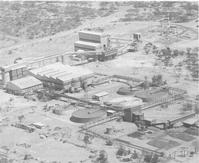


Chapter 10
I 1. Introduction
II 2. The Role Of Technology
III 3. Some Highlights Of Australian Minerals Technology
i Gold
ii Copper
iii Lead-zinc-silver
iv Technology in iron ore mining
v Iron and steel technology
vi Nickel
vii Mineral sands
viii Bauxite, alumina, aluminium
IV 4. Other Technological Achievements (in brief)
V 5. Export Of Technology
VI 6. Education And Research
VII 7. The Scientific Societies
VIII 8. Conclusion
References
Index
Search
Help
Contact us

Nickel
From being little more than a mineralogical curiosity in the Australian scene, apart from a tentative and short-lived interest in a small copper-nickel mine in the highly mineralized area of the West Coast of Tasmania, nickel has become in the last twenty years a major component of the mineral industries of Australia and a substantial figure in the world scene with a capacity of 90,000 t/yr of nickel equivalent to some 11 percent of world production. The discovery of a massive sulphide orebody at Kambalda, WA, in 1966 was followed by development to large scale production in record time; shipment of flotation concentrates was achieved in 1967 less than two years after the discovery, followed by completion of the Kwinana hydrometallurgical plant in 1970 and the Kalgoorlie smelter in 1972. These were extraordinary achievements by any standard. The period included a number of other discoveries of nickel sulphide ore-bodies in various sections of the WA goldfields, under the geological and economic stimuli of the Kambalda experience; several of these new discoveries were developed to production and continued operations until the downturn in the world economy in the late 1970s.In the same initial period of the WA discoveries the lateritic deposit at Greenvale, Qld. was developed to production in 1974 in the hydrometallurgical plant at Yabilu. Cobalt is a significant co-product with nickel in this orebody, and is recovered in a mixed nickel-cobalt sulphide for export.
A subject of much discussion in respect to the WA nickel industry has been the oversight of the sulphide occurrences in areas which had been extensively prospected for gold for over 70 years and which offered powerful clues in the similarity of the geological environment to that of the Sudbury section of the Canadian Precambrian Shield; there were also metallurgical clues in the cyanidation plants and gold refineries of the operating gold producers. Valuable lessons have been learned from the experience; exploration programmes are now much more comprehensive, aided, of course, by the advances in exploration techniques in aerial and satellite surveys, coupled with the new generation of chemical instrumentation and computer recording and enhancement. A recent example is the discovery, by drilling based on geophysical indications, of the massive Radio Hill nickel-copper sulphide deposit in the Western Pilbara. This deposit had no surface expression and no secondary minerals even though the deposit is only 17 m below the surface. Exploration programmes of this calibre are also yielding valuable data in respect to other metals and minerals of special concern to highly important evolving industries, including platinum, the rare earths and components of electronic devices and superconductors.


 |
Australian Academy of Technological Sciences and Engineering |  |
© 1988 Print Edition page 761, Online Edition 2000
Published by Australian Science and Technology Heritage Centre, using the Web Academic Resource Publisher
http://www.austehc.unimelb.edu.au/tia/724.html